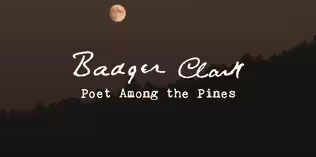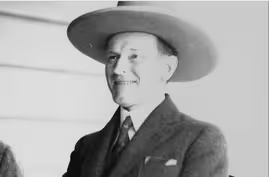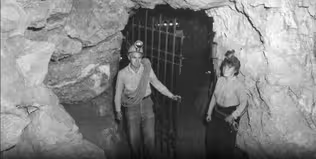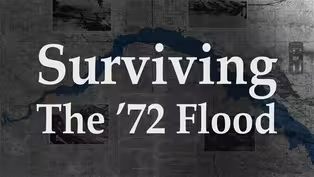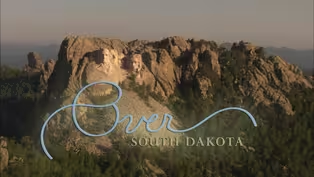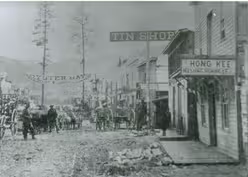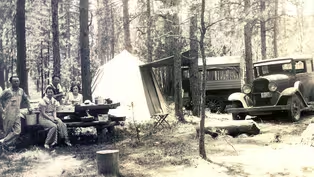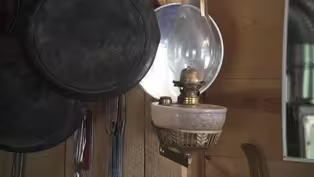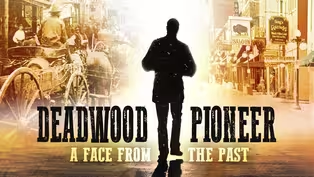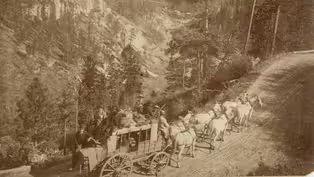SDPB Documentaries
Galena: The Ghost Town that Refuses to Die
Special | 24m 37sVideo has Closed Captions
The spirit of the residents of Galena, SD is the reason it’s a “ghost town that refuses to die.”
Galena, South Dakota, a historic mining town nestled in the Black Hills, is often considered a ghost town but is far from being completely abandoned. Thanks to the dedication of its residents and the preservation efforts of the Historical Society, Galena is truly a "ghost town that refuses to die."
Problems playing video? | Closed Captioning Feedback
Problems playing video? | Closed Captioning Feedback
SDPB Documentaries is a local public television program presented by SDPB
Support SDPB with a gift to the Friends of South Dakota Public Broadcasting
SDPB Documentaries
Galena: The Ghost Town that Refuses to Die
Special | 24m 37sVideo has Closed Captions
Galena, South Dakota, a historic mining town nestled in the Black Hills, is often considered a ghost town but is far from being completely abandoned. Thanks to the dedication of its residents and the preservation efforts of the Historical Society, Galena is truly a "ghost town that refuses to die."
Problems playing video? | Closed Captioning Feedback
How to Watch SDPB Documentaries
SDPB Documentaries is available to stream on pbs.org and the free PBS App, available on iPhone, Apple TV, Android TV, Android smartphones, Amazon Fire TV, Amazon Fire Tablet, Roku, Samsung Smart TV, and Vizio.
More from This Collection
Stories of the Black Hills and Badlands of South Dakota
Badger Clark: Poet Among the Pines
Video has Closed Captions
South Dakota’s first Poet Laureate defined the spirit of the Old West in his poetry. (55m 45s)
Coolidge: Rediscovering an American President
Video has Closed Captions
A century after taking the oath of office, the presidency of Calvin Coolidge is examined. (57m 10s)
The Ups and Downs of Herb and Jan Conn
Video has Closed Captions
Herb and Jan Conn are legendary Black Hills pioneers. (30m 2s)
Video has Closed Captions
Survivors of a deadly 1972 flood in Rapid City, South Dakota, tell their stories 50 years (56m 46s)
A breathtaking aerial look at South Dakota's landscape and points of interest. (56m 45s)
Deadwood's 'Days of '76' Parade and Rodeo
Video has Closed Captions
Documentary about Deadwood's annual celebration of it's frontier past. (26m 53s)
Video has Closed Captions
Four private collectors of historical images share a passion for South Dakota history. (28m 48s)
A Century of South Dakota State Parks
Video has Closed Captions
Celebrating the centennial year of the founding of South Dakota's State Park System (28m 47s)
Settlement Stories: The Frawley Ranch / Mennonite Settlement
Video has Closed Captions
Two stories from South Dakota's settlement days. (28m 55s)
Deadwood Pioneer: A Face From The Past
Video has Closed Captions
See how modern forensic technology helps puts a face on a 150 year old mystery. (53m 16s)
Trails, Rails, and Roads of the Black Hills
Video has Closed Captions
How transportation and infrastructure have evolved in the Black Hills and the region. (28m 49s)
Piece of Heaven - A Brief History of the Mickelson Trail
Video has Closed Captions
A history of the development of South Dakota's Mickelson Trail (29m 3s)
Providing Support for PBS.org
Learn Moreabout PBS online sponsorshipWhat?
What makes a ghost town?
And how many ghost towns are in the Black Hills?
Well, there are a lot of towns.
The Black Hills that came and went.
And those would be by, I guess, some definition.
Ghost town.
That's the definition of a ghost town, isn't it?
A town that boomed once and then is no more.
It's abandoned.
If you look in the dictionary, totally abandoned.
And in essence, dies.
I always thought of it as the little ghost town that refused to die.
If you look at Galena, Galena was a silver camp, and Galena always seemed to maintain some people because of its proximity to Deadwood.
I would argue.
And also because there's always people that were trying to find the silver vein that was missed.
A little more wealth.
There was gold nearby.
The gold did well for a while.
That kept stimulating the economy.
So this puts the Black Hills out as is perhaps last example of the gold rush.
And so much of the westward migration is driven by, a drive for wealth, at least from our American viewpoint, a mining town.
By the very nature of being an expendable resource.
We'll have your your discovery, which creates a rush to the town.
And so people rush in, and then you have, the founding of the town.
Now, a town like Galena had a small boom, certainly when prospectors came through.
And.
But think about the boom in early Galena.
What were these prospectors looking for?
That you're looking for gold.
So there was no placer gold that caused this big rush.
And that's what really causes a big rush.
But they did recognize another viable commodity, which was silver.
Hence the name Galena.
It's a derivative of silver lead or sulfide.
Silver.
That ore.
This was the silver mining down here.
And then the gilt edge people lived here too, and they were mostly gold.
Mines were all over the hills.
The history is is mainly small mines in the area, both out silver and some gold mines.
Silver would go down.
People would leave, and when silver went up, people would come back.
But there's always a few people that stayed.
There was enough silver to support those few families and it just kept happening that way.
The markets, the silver market, gold markets fell off.
The workers moved to other areas looking for jobs because, the weather frightful for them at that time to process up the gold here.
The silver was here, but it wasn't worth their time to try to produce it.
Everything is built here.
Just let idle roughneck mining community back in the day.
Now, just a simple little residential with ten houses, if you will.
Probably about 1942 43.
The school closed finally, in 43 because people left and they started tearing buildings down because they needed the wood for other purposes.
And.
That was one thing Fred did a lot.
He had collected a lot of mining claims.
An employee named Walt Wittwell worked for him in the liquor store.
And his brother Ollie found Tootsie out at Custer Peak or near Custer Peak and picked her up for the bounty.
But then when they got her into town and all of them saw how cute she was, they didn't want to have her killed.
So, she.
Fred took Tootsie home.
Fred Borsch, the the third, adopted the coyote and had a dog and taught the coyote how to howl and and but in 1949, it became the state animal.
For ten years, this guy was a hit.
You know, Fred got it to sing songs, more or less.
And they recorded records.
South Dakota Tootsie official coyote is calling you.
He ran the Spot Liquor and and Deadwood.
He bring the coyote there, but he made it like, I think it was on Lawrence.
Welk, you know, Tonight Show on various TV shows was in parades across the country.
Omaha, part of promoting really, the Black Hills and Deadwood.
Tootsie the Coyote was this big hit, [♪Tootsie Coyote, Tootsie] [♪Forever] [♪you will be] They had Tootsie them till 59.
She lived quite a long time.
I've never petted Tootsie.
She stayed in our house in Seattle one time and she just growled at me.
She never got to know me.
My brother said that he got acquainted with her.
Kind of.
He could drive the jeep and she wouldn't bite him.
00030 [♪ Gentle piano music playing] [♪ Gentle piano music playing] [♪ Gentle piano music playing] [♪ Gentle piano music playing] She got Ahold of my dad's overcoat one time when she is driving that she saw he didn't belong there.
I met old Fred Borsch.
He gave me a tour of his house, probably 1975 or 6.
I and my, and two friends were walking down the street, right down the middle of Galena Road, and, and the guy in an old rickety jeep pulled up, and it was Fred and of course, set on the jeep to see the coyote.
And he gets out, introduces himself, and promptly poses for pictures.
And so I have a picture of Fred on his Jeep.
And then he took us to his house and gave us a tour because he had quite a collection.
And, he told me the story.
He said, you know how I got the coyote to howl on command for the coyote?
The coyote loved chocolate.
So I get a a Hershey's chocolate bar.
And he said, I break off one of the squares because they're in squares, and lay the square in front of Tootsie to see the square and layout of how, and sit down and eat the square of chocolate.
And that that was the process of getting Tootsie the how on command.
You go up to the cemetery and of course, to get Fred Borsch up there and the the image of Tootsie on on the, on his headstone.
So it's a little confusing.
It is deceptive makes you think that Tootsie might be buried there, but the They told me Tootsie's in that patio.
They have a very active, preservation group who works on the school.
They have a very active community of people that know each other and work together in their historic society.
Yeah, it's a very strong sense of community.
It's very strong sense of passion about the town and its history and the people that came before.
The Galena Cemetery is dedicated to the men, women and children who lie here, so many of them unknown or forgotten through the years.
Their names sing of their original Brooks, Calvert, Campbell and Purlie.
Some buried backgrounds Some native lands from the frontier days to the Civil War.
These men and their families wrote a significant chapter in history.
They followed a dream of a better life.
And sometimes that life was filled with glory, camaraderie and laughter, but just as often with drudgery, alienation and tears.
Many lives ended too soon, and now they lie here with their dreams unfulfilled.
Some of those who are buried here are a great deal of information was found, while for others only their deaths were noted.
Some came a long ways to die.
I got involved in the cemetery too, but there was no record.
No official record of cemetery.
That drove me to research again.
For people who are in the cemetery up there and not like a three year process.
And, and that's why you see names and crosses up there now.
But no, that's Don and Melinda's.
The Redeemers have just done wonders with that cemetery.
They are phenomenal.
We are very lucky to have them.
The first, burial that we had up there was a child.
Shadrach Neal.
He was a four year old child that stepped on a nail, and he was buried up there when we were cleaning up the cemetery on the third year, I believe we found a rock carved for Shadrach Neal.
And that's where we started.
I don't visit family grave sites, but that first year we went up to the cemetery and saw Henry's grave.
Just had a strong need to talk to him, put my hand on the grave.
I am with Ruth Halverson's daughter Elaine and.
I've heard a lot about you, and I'm so thrilled to have done that and just talk to him a little bit.
By the time I left, I had a little tear running down my cheek.
That's the only grave that draws me to visit.
I guess that could be because I studied and learned so much with the help of people that just unexpectedly drop into my life over a range of two years.
My brother is the last one buried there related to us, and my great grandmother's there, and, Fred's there, Fred and Esther and several other great aunts and cousins, so.
Oh, it's the most beautiful place in the mornings.
You know, when you go up there, it just there's just a serenity and of the old headstones and the history and, and, of the area that way that is buried up there and the families and, and the names and stuff.
Everybody's got a story that, you know, how they ended up in Galena and and how they ended up being buried in cemetery.
Galena has a lot of stories.
And, and the cemetery has some to one fella request to be buried in a 45 degree angle so you can see the sunrise.
I believe that's true.
Not the ones that are supposed to be a horse buried up there.
I can't find nothing about that.
There's.
What's up there about being a witch.
And, her, grave site is covered with wood, wrought iron.
So she can escaped.
We worked on it being down, and Glenda, we wrote on her grave site.
There's a family site up there, and we took all the rod iron off, and we did the cement work and, things like that.
And then that fall, there was a picture taken accidentally, and there's a ghostly shadow right behind her grave site for her.
It's Mary.
I don't know how it got there, but it's Mary.
She's not dangerous though.
In an essence of a community is knowing neighbors and having neighbors as or people within the area call them neighbors.
Work together, glean as viable that way to day.
But when did that really start?
When did the historic site become viable?
I think at the 1980s they started picking up.
And so I think that was restored, particularly as I saw, I think maybe some of their history lost and being lost.
And this, you know, was a common phenomenon.
And I think in the 80s, people became much more words to 70s, 80s, much more worried about historic preservation, remembering our past, preserving our past.
And Galena, I think they every June or sponsor ghost town walk and and they highlight where businesses were.
They take over their cemetery and they have a wonderfully nicely preserved cemetery.
And they have other sites that are very interesting to look at as part of their history.
What they're doing is bringing back memories of the past to the glory days of Galena, and highlighting the.
So in that essence, these memories are the ghosts that walk.
Yet among them.
Well, I think the walk just been going on now for almost 20 years, and we still get several hundred people each time.
Sep.
Last year when it rained all day, we all sat in the garage and talked to each other.
The people that set it up.
So but it's it's helped a lot with the school.
Now the school looks really nice.
Well, we started it.
Just all the pictures we could find of how it used to be.
We put up where they actually were and people really taken an interest and they just like to come back to.
But the internet picked up on everything they, they have.
All the pictures we had are all on the internet now.
Several times.
It's funny, everybody seems to like to to work on it.
So they the same people keep showing up.
If people are truly interested in history, then it does become relevant.
And to see old buildings, the schoolhouse being the biggest one.
Cemetery is also a huge draw up here.
The other thing it on on the walk is because, you know, a big part of it is the schoolhouse, which was established in 1882 because there was families with school age children that they wanted them to go to school.
And, it was a hardship for quite a few people to get their kids to school.
And, but they made the effort.
Had a school teacher building, a very nice school, which is still standing today.
Yeah, just to share what I can.
And it's neat and it's it isn't.
It gets a little bit of history back here.
Not much left because it's there's only 3 or 4 houses that are from back in the area.
Well, and it's, it's really neat to see whole families like like the Halverson you know, the different, the different generations come.
We have grandma, we have sons and daughters.
We have grandkids.
So yeah, I just think it's really a neat way for families to get out, kids to get out and be in nature and see and see the history and learn about how people lived back then and how hard it was, chose them away that they lived before and some of the hardships they've had and some of the progress that they've made.
It was, a quite an effort, I guess, to keep the community going back then.
And that's what we try to show the what it was like and to the different families and the history that that day created, well, for me is basically to, carry on the history of Galena to, people who are interested in come here.
We set up different displays into, what I like about it is, we got photos on the street.
All of the buildings used to be.
And people used to be.
So the walk, you walk the street, stop and read about that section of where you're at.
And of course, this relates to me because my great grandfather was here.
I'm not I'm doing it for him.
That's how I feel about it.
It's for my relatives, my great grandfather era, when he came here in 1897.
That's the same time this building is being built.
And Ira He was, part of the Galena Teamster Union.
In 1907.
He was the treasurer for the for the union.
And then after that, that's when you got in the mining business.
I'm sorry, the salon business, he tried to get into saloon business in 1904.
It didn't work out.
1906, he was part owner of a saloon of that of that time a saloon right here called the cornerstone previous the Scaleless Bill saloon.
And then in 1906 1907, he became the full owner of the saloon.
And so he was a businessman at that time.
Well, I mean, the ghost walk may Provide more insight of the this town itself, the only stare at ghost towns you drive by, you see a sign?
Not much known about it.
Galena has captured some of this history to preserve it for future generations.
Who has an interest in history So it's kind of unique that way that we can be able to share that with visitors.
I believe it is a ghost town for the reason that Galena is a ghost of a town.
There's no businesses, no schools.
So Galena is still here It's maybe a small community, but it's not a town.
All your history books that you read, it calls Galena a ghost town now, but, no, we don't feel like we live in a ghost town, because there there's, you know, quite a few families that actually live here.
It's alive.
Yeah, put it that way.
People like to visit here.
People are coming to the cemetery all the time.
The ATVs go by here constantly.
We're on the official ATV trail.
Our driveway is actually so.
We're not lonesome.
I like it, it's the way it is.
Yeah, some.
Some of the older ones don't like the word ghost town, but it is an old ghost town.
That's just the way it is.
It's the the ghost of how it was in the past.
At one time, it was very vibrant, you know, alive community, community.
It had boarding houses, saloons, you know, hotels, blacksmith shop churches.
You know, I mean, it it was a going community.
But as the silver and the mines played out, up until even up to World War two, when all the mining activity was stopped by the government, I mean, that pretty much killed, the small towns in the hills.
So that was kind of a a turning point.
Yeah.
When World War Two started, the United States needed bullets and bombs and stuff.
They went around to all the old mines and took all the materials to help.
They hauled along tons and tons of scrap iron, all the old machinery and everything, and cleared a lot of that all out, went into scrap metal for the for the war effort.
So that really took a lot of the, the physical, you know, things the old mines and stuff were yeah, were gone and so that's how a lot of your structures disappeared.
I mean, there's 20 of us roughly in this community, and there still are abandoned houses about and it's been a ghost town.
It is.
Totally went defunct.
Yeah.
Now that there's some people living here, it's still a neat little, name, fun.
But, yeah, there's people living here.
I know some people are kind of opposed to it because there are people living here, but it's it's a fun little novelty.
This is not the normal ghost town.
There is no more.
I mean, there are buildings that are falling down and there are buildings that are barely there and buildings that are really leaning and no paint and all of that, the shops and the hotels and boarding houses are gone.
I always thought of it as the little ghost town that refused to die.
It's just doesn't want to die.
And I think there's always been a few families here.
It was not the thriving town, mining camp, whatever that was.
It's not all tattered and fallen down, but it's just a ghost town.
Well, I hope because we're not the old generation.
We're kind of the mill generation of.
For doing, I'm hoping that, people will move in here.
They will say they come from here.
Let's just fine.
I understand that, but I hope they catch more interest to keep Galena history alive.
To keep the walk alive, too.
Keep moving forward in the public.
That that's the best thing can happen to Galean Yeah.
Just keep the knowledge alive.
Once you shut the book and shut the door And the people, you know, disappear.
Support for PBS provided by:
SDPB Documentaries is a local public television program presented by SDPB
Support SDPB with a gift to the Friends of South Dakota Public Broadcasting
